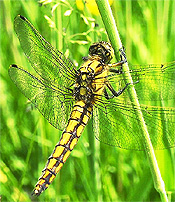Organic Metaphor
Instructions
Recall that the word metaphor comes from the Latin metaphora, which means to carry over. A metaphor in poetry “carries over” the idea of one thing to another.
Think of a few more words you know that begin with the prefix meta -. Metamorphosis, metastasize, metatarsal are a few. For metamorphosis then, meta: among, with, after + mrophe: form.
Think of the way an insect changes form in metamorphosis, and consider how a poet uses words to change the form of meaning.
In this exercise, we will carry over the idea of one subject to an object, and from there, create a poem based on your responses to the exercise that follows.
At the core of this exercise you will create a draft that arises organically from the metaphor you create.
You will write a poem that arises organically from your original line of metaphor, and from there, expand the poem to include the five senses and narrative elements.
TO GET YOU STARTED
Let’s begin by making a word list.
What things do you like? Make a list of five things -- individual nouns -- that you like. You may wish to write these out on a sheet of paper folded in four columns.
Write a list of things that you like in the second column like this:
|
|
horse star ocean tree bicycle …. |
|
|
Now write a list of your favorite activities in the third column, as follows. Specifically, strong action verbs are best:
|
|
horse star ocean tree bicycle …. |
run dance ride swim sing …. |
|
Let’s make a metaphor using a part of your body to begin your metaphor. Hand, heart, eyes, hair, tongue; facial parts work best.
We are going to make a metaphor of our hand, but when you do this on your own, you may chose another part of your body.
Write the word hand in the first column, thus:
|
hand |
horse star ocean tree bicycle …. |
run dance ride swim sing …. |
|
Now combine the words from all three columns to form a complete sentence, adding the word IS between the first and second column to complete the metaphor.
My hand is a horse running …
Where is it running?
Add your responses in the far right column. Give several responses, thus:
|
My hand (is) |
|
|
|
COMBINING ALL THE ELEMENTS
Finally, combine all elements to form a complete sentence.
My hand is a horse running by the ocean.
Now try selecting any group of words in random order to make a complete sentence, e.g.:
My hand is a star running with a lost rider.
My hand is a tree singing to my friend’s house.
My hand is a bicycle riding in a storm.
Be as funny, quirky and unusual as you can.
Now try adding different body parts in the first column and see what you get.
My heart is a bicycle riding with a lost rider.
ADDING IMPORTANT DETAILS
To complete this writing exercise in organic form, give details that explain: what, when, where, how, and why.
What is the size of the hand? How fast is it riding? When does it ride? Where is it going? Why is it going there?
Before you begin writing, complete several more sentences in the manner above, and when you have written three or four sentences, select your FAVORITE sentence, and use THAT sentence as the first line of your poem.
FINISHING UP YOUR FIRST DRAFT
Complete this exercise by writing ten to fifteen lines wherein you describe the who, what, when, where, how and why of your starting sentence.
Use the five senses we considered from our first exercise in your first draft here to make your poem more vivid.
Your poem will arise organically from the first sentence.
Emily Dickinson's Hope is the thing with feathers is an exellent example of how a poem starts with a metaphor in the first line and then develops organically.
Thank you for writing this exercise.
Please write a poem using metaphor, in fifteen lines or fewer, and submit it for consideration on the APW Forum/Guests' Pages. Email subject line: Metaphor Poem.
Enjoy!

